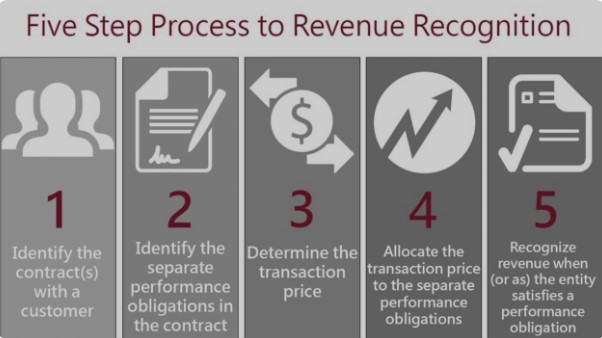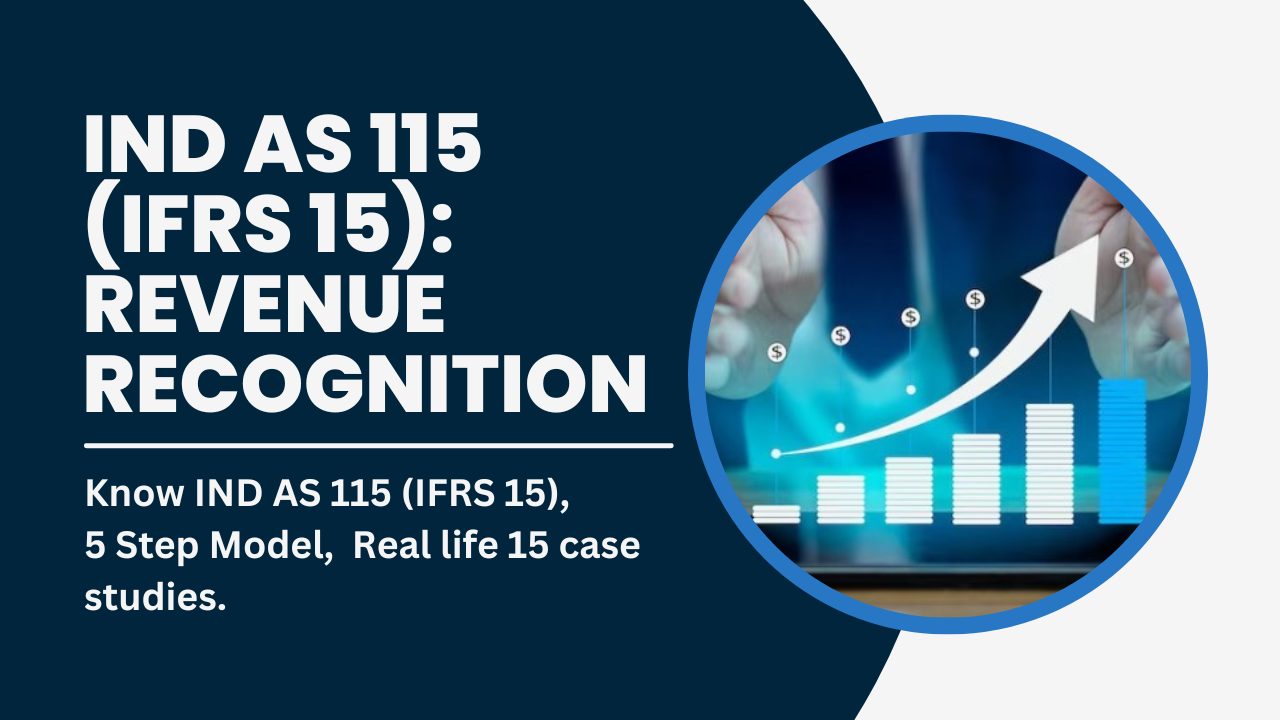IFRS 15 Revenue Recognition, the international standard for revenue recognition, lays down the rules to ensure that companies report their revenue accurately, reflecting the true financial health of the business.
Understanding Ind AS 115 (IFRS 15): A Simple Guide to Revenue Recognition
In the world of accounting, there’s a set of rules that help companies properly recognize their revenue. One of these important rules is called IFRS 15, which stands for International Financial Reporting Standard 15. This standard guides companies on how to record their revenue from contracts with customers. Let’s break it down in simpler terms.
What is IFRS 15 and Why Does It Matter?
Imagine you run a company that sells laptops. When someone buys a laptop from you, you don’t get all the money upfront. Maybe they pay some now and the rest later, or maybe they pay in installments. IFRS 15 helps companies like yours figure out how to show this money in their financial statements over time.
Before IFRS 15, different companies used different methods to recognize revenue, which made it tricky to compare their financial health. This standard makes things more consistent and transparent, giving investors and other stakeholders a clearer picture of how well a company is doing.

The 5-Step Model of Revenue Recognition
Okay, so how does this IFRS 15 thing work? It’s got a simple 5-step model that guides companies through recognizing their revenue:
Step 1: Identify the Contract with the Customer
First, you need to have a contract in place. This means you and your customer have agreed on what you’re selling, at what price, and under what terms.
Step 2: Identify the Performance Obligations
Performance obligations are the things you promised to do for your customer. If you’re selling a laptop, it might include delivering the laptop, offering software updates, and maybe even some customer support.
Step 3: Determine the Transaction Price
How much money will you get from the customer? Sometimes, there might be discounts, refunds, or other factors that affect the final price.
Step 4: Allocate the Transaction Price
If your customer is getting more than one thing from you, like that laptop and future software updates, you need to split the price fairly between these things.
Step 5: Recognize Revenue as Performance Obligations Met
As you fulfill your promises to the customer, you gradually recognize the revenue. For the laptop example, you’d recognize revenue as you deliver the laptop, provide updates, and offer customer support.
In a nutshell, IFRS 15 helps companies show their revenue in a way that makes sense and follows a clear process. This benefits both the company and anyone looking at their financial statements.
So, the next time you hear about IFRS 15, just remember that it’s like a rulebook that helps companies play fair with their revenue recognition and gives everyone a better view of the business world.
Keep learning about the Accounts Receivable Process.

Case Studies on Revenue Recognition
Let’s dive into 15 real-world case studies that shed light on how IFRS 15 is applied in different scenarios.
Case Study 1: Sale of Goods
Company A sells widgets to a customer for $10,000. The customer pays upfront.
According to IFRS 15, since the goods are transferred at a point in time, the revenue of $10,000 is recognized immediately upon delivery.
Case Study 2: Long-Term Contracts
Company B signs a contract to build a complex machine for $100,000. The contract will take a year to complete.
Under IFRS 15, revenue should be recognized as the work progresses. If, after six months, 50% of the work is done, $50,000 would be recognized as revenue.
Case Study 3: Subscription Services
Company C offers an annual subscription service for $1,200. Customers pay upfront.
IFRS 15 dictates that revenue should be recognized over time as services are provided. So, each month, $100 is recognized as revenue.
Case Study 4: Variable Consideration
Company D sells a product for $500, but there’s a 10% chance customers might return it.
IFRS 15 calls for estimating returns and adjusting revenue. In this case, revenue would be initially recognized at $450 ($500 minus 10%), with the possibility of adjustments later.
Case Study 5: Bundled Goods and Services
Company E sells a computer for $1,000, bundled with a two-year warranty for $100.
IFRS 15 requires separating the revenue for the computer and the warranty. $900 would be recognized immediately for the computer, and $100 would be recognized over the two-year warranty period.
Case Study 6: Sales with Right of Return
Company F sells products to customers with a right to return them within 30 days. If historical data suggests a 5% return rate,
IFRS 15 stipulates that revenue should be recognized net of expected returns. So, if $1,000 in products were sold, only $950 would be recognized initially.
Case Study 7: Multiple Performance Obligations
Company G signs a contract to provide software and training for $5,000. The software is delivered immediately, but the training will occur over three months.
IFRS 15 requires allocating the total transaction price to each performance obligation. In this case, $3,000 might be allocated to the software (recognized immediately) and $2,000 to the training (recognized over three months).
Case Study 8: Partial Satisfaction of Performance Obligation
Company H enters into a contract to design and build a custom website for $10,000. The design is completed in the first month, but the development work will take three months.
IFRS 15 mandates recognizing revenue proportionately as performance obligations are satisfied. In this scenario, around $2,500 might be recognized in the first month, and the remaining $7,500 would be recognized as the development work progresses.
Case Study 9: Significant Financing Component
Company I sells equipment for $20,000 with an option to pay in six months.
IFRS 15 requires considering the time value of money in such cases. The company would recognize revenue of less than $20,000, accounting for the financing component.
Case Study 10: License of Intellectual Property
Company J licenses its software for $15,000 upfront and ongoing royalties of 5% on sales.
IFRS 15 dictates separating the upfront fee from the ongoing royalties. The upfront fee would be recognized immediately, and the ongoing royalties would be recognized as sales occur.
Case Study 11: Termination Penalties
Company K enters into a contract with a customer, but the customer terminates the contract early, leading to a $2,000 penalty.
IFRS 15 requires evaluating whether the penalty represents compensation for a loss of expected revenue. In this case, if it’s determined that the penalty is compensatory, it might be recognized as revenue.
Case Study 12: Variable Pricing
Company L offers a service priced at $100 per hour. However, due to a long-standing relationship with a customer, they are given a 20% discount.
IFRS 15 requires determining the transaction price by considering variable pricing factors. In this example, the revenue would be recognized based on the discounted price.
Case Study 13: Franchise Arrangements
Company M grants a franchise for $50,000, entailing initial training and ongoing support.
IFRS 15 necessitates separating the initial training fee and the ongoing support fee. The initial fee might be recognized upfront, while the ongoing support fee would be recognized over time.
Case Study 14: Licensing Arrangements
Company N licenses its software for $10,000 per year. IFRS 15 guides recognize revenue over the license term, spreading the $10,000 fee across the license period.
Case Study 15: Sales with Uncertain Collection
Company O sells goods for $5,000 to a customer with a history of late payments.
IFRS 15 addresses uncertainty in collecting payments by requiring revenue recognition only when the collection is reasonably assured. In this case, revenue might be recognized once the customer makes a payment or demonstrates a commitment to pay.
These case studies exemplify the practical application of IFRS 15, showcasing how it navigates the intricate landscape of revenue recognition across various business scenarios. By adhering to these principles, companies ensure transparent financial reporting, better decision-making, and increased confidence among stakeholders.
